

Technical Talks with George Krampera. KV2 Audio » Technical Talks with George Krampera PART I: Time - the Missing Dimension in Today's Professional Audio Industry To understand how the principles of Super Live Audio technology provide superior audio performance, we first need to look at the three main parameters that make up sound – frequency, level and time.
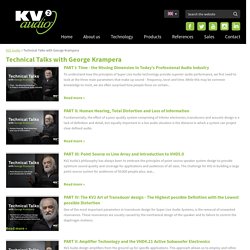
While this may be common knowledge to most, we are often surprised how people focus on certain... The End Fire Cardioid Subwoofer Array Made Visible. The end fire array is one of the most talked about – even if not the most often implemented – of the cardioid subwoofer arrays.
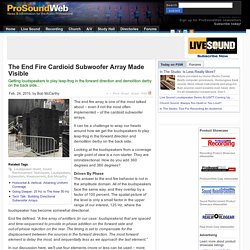
It can be a challenge to wrap our heads around how we get the loudspeakers to play leap-frog in the forward direction and demolition derby on the back side. Looking at the loudspeakers from a coverage angle point of view is a non-starter. They are omnidirectional. How do you add 360 degrees and 360 degrees?
Design Principles For Distributed Systems: Implementing Subwoofers. Subwoofers can make the difference between good and great business music systems.
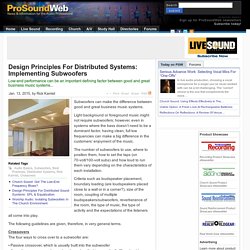
Light background or foreground music might not require subwoofers; however, even in systems where the bass doesn’t need to be a dominant factor, having clean, full low frequencies can make a big difference in the customers’ enjoyment of the music. Tuning A System With FFT: Getting It Close Without Listening. You’ve just acquired a 3-D, FFT-based measurement system and are ready to use it to tune a sound system.
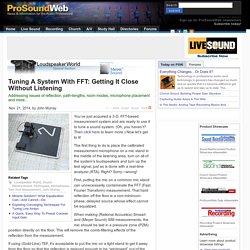
(Oh, you haven’t? Then click here to learn more.) Thinking Inside The Box: Insight Into Low-Frequency Behavior. Suppose you bought the best subwoofer that money can buy.
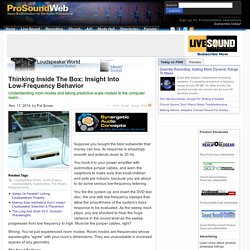
Its response is amazingly smooth and extends down to 20 Hz. You hook it to your power amplifier with automotive jumper cables, and warn the neighbors to make sure that small children and pets are indoors, because you are about to do some serious low-frequency listening. You fire the system up and insert the DVD test disc, the one with low-frequency sweeps that allow the smoothness of the system’s bass response to be evaluated. As the sweep track plays, you are shocked to hear the huge variance in the sound level as the sweep progresses from low frequency to high.
PA Basics. Staying safe on stage is more than a matter of simply making sure that willing hands are available before taking a dive.

Knowing how to properly handle the mains power we all need is also crucial to performance health... Feature by Mike Crofts Photographs by Mike Crofts Whatever the size, complexity or cost of your live sound rig, one of the first — if not the first — question on your mind when you get to a venue will usually be "where do I plug it in? " Step By Step: A Growing Company Does Festival Double-Duty. We next stopped by front of house at the Bud Light Stage, chatting with Nicholas Radina, who was providing mixes on a Yamaha QL5, feeding a PA with 10 NEXO GEO S12 modules per side, flown, with eight NEXO RS18 “Ray Gun” subwoofers placed equidistantly on the deck in front of the stage.
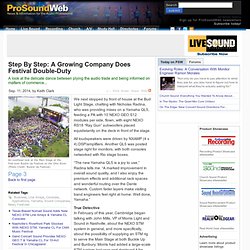
All loudspeakers were driven by NXAMP (4 x 4) DSP/amplifiers. Another QL5 was posted stage right for monitors, with both consoles networked with Rio stage boxes. “The new Yamaha QL5 is a joy to use,” Radina tells me. “A marked improvement in overall sound quality, and I also enjoy the premium effects and additional rack spaces and wonderful routing over the Dante network. Custom fader layers make visiting band engineers feel right at home. A Practical Guide To dB Calculations. This is a practical guide to doing dB (decibel) calculations, covering most common audio situations.
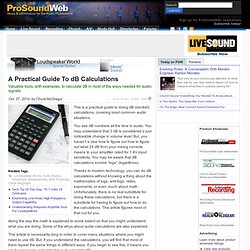
You see dB numbers all the time in audio. You may understand that 3 dB is considered a just noticeable change in volume level. But, you haven’t a clue how to figure out how to figure out what 24 dB from your mixing console means to your amplifier rated for 1.4V input sensitivity. You may be aware that dB calculations involve “logs” (logarithms). 30 For 30: Lessons Learned From Years Of Tuning Sound Systems. Live Sound Sep 2014. Church Sound: Church Sound: The Art of Snare Mixing…And A Frog. I created a frog.
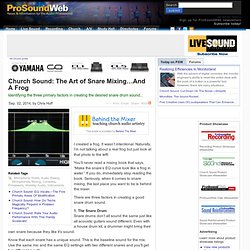
It wasn’t intentional. Naturally, I’m not talking about a real frog but just look at that photo to the left! You’ll never read a mixing book that says, “Make the snare’s EQ curve look like a frog in water.” If you do, immediately stop reading the book. What Is [Live]? – The New Generation Of Live Techno. Church Sound: Church Sound: 12-Step Program—Key Questions In Critiquing Your Live Mix. It’s OK to steal.

Wait – allow me to rephrase that. It’s OK to steal from studio engineers. Live audio is a different beast compared to what happens in the studio, yet my live mix quality skyrocketed once I started reading the works of studio engineers Roey Izhaki, Bobby Owsinski, and Mike Senior. Last year, I stole…uh, found…a list of questions that studio folks ask in critiquing their mixes. The questions largely focused on emotion, energy, and clarity. In The Studio: 4 Tips For Better Gain Staging. Maintaining proper levels throughout your signal chain is important for achieving great tone. This is an important discussion for guitarists and engineers. I think pretty hard about my gain staging when I’m tracking. When Eyes And Ears Don’t Agree. Reality Distortion? We work in an industry where a lot of money is made by distorting reality.
You can drop a thousand dollars on a processor that essentially increases the harmonic distortion of your system or fills its response with deep notches, and feel like you have improved its sound quality. Yet no one buys a processor for a television that makes the grass look blue or the sky look green. Extremes: Utilizing DSP On The “Low Lows” And “High Highs” Years ago, a couple of smart guys named Thiele and Small characterized the behavior of cone drivers.
Do You Speak Geek? The Unique Language Of Audio Analysis. In my lifetime, the size of sophisticated audio analysis systems has evolved from table top, to under-airplane-seat, to computer bag, to cell phone. Educational Resources « Synergetic Audio Concepts. One Systems - Technical Papers and Installation Guides. Phase Alignment Between Subwoofers And Mid-High Cabinets. FFT-based field measurement systems have made it possible for us to do phase alignment at fixed installations as well as at live events, where every venue demands a different approach. Soundindex/How far will the Line Array Speaker effect extend? - SounDoh. Top / Soundindex / How far will the Line Array Speaker effect extend? The Line Array speakers have been installed in many reverberant places to increase the speech intelligibility. Because they have big features for improving the sound quality. However, those features have physical limitations of the effect.
Below easily describes the advantage and extent of effect. Controlled dispersion minimizes reflected sounds from ceilings and walls.Acoustic feedback is suppressed.Clear sound reaches the remote target area. How Loudspeakers Work: Part 2. Sound Advice : Tech Notes. Signal Processing Fundamentals: Passive & Active Crossovers. Everything You Wanted To Know About Line Arrays (And Then Some) The Birth of the Array Part One – Concert Sound Overview. Did I Hear Someone Say “Line Array?” The problems and limitations of the conventional speaker array were very clearly understood by the mid 80s.
10 Things about Audio Amplifiers You've Always Wanted to Know. Power Amplifier Fundamental. Understanding Phase. Mc Squared System Design Group, Inc. - Interpreting Loudspeaker Specs. How Speakers Work" Understanding the Basics of Live Sound. The Anatomy Of An Audio Rack. History Files: The Crown DC300 Amplifier Leads The Solid-State Revolution. Linkwitz-Riley Crossovers. Driver-Time-Alignment.pdf. Proper Signal (Time) Alignment. PA Basics. ADWL Videos. Introduction to the Amplifier - Amplifier Tutorial. Undertanding Power Amplifier Power Ratings. Power Amplifier Fundamental.
How much amplifier power do I need? Belchfire datasheet.pdf. Shure Live Mics.pdf. Line Arrays explained. The ABC’s of Line Array Tuning. Electronic Versus Physical: An Analysis Of Shaping Array Directivity. An Analysis Of Shaping Array Directivity. Line Arrays vs. Point Source. Funktion-One handles audio duties for three Glastonbury stages. Live Systems LMT. On Stage Lighting. Live Sound - Articles. Running An Open Air Concert. Sound System Gain Structure. EQ Of Loudspeakers. Equalizing The Room. Exploring Converging Techniques For Tuning Line Arrays. Why Is Distortion Overlooked In Loudspeakers?
Make It Stop! There’s No Excuse For Loud, Bad Sound. Tuning System Without Tools.